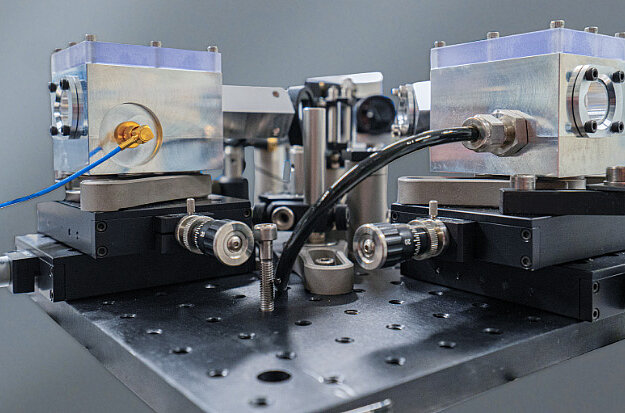
MADEIRA

The ability to characterize the carrier-envelope-phase (CEP) of few-cycle pulses is the backbone of attosecond metrology and key to achieving sub-cycle temporal resolution in a wide range of ultrafast laser applications. UFI's single-shot phasemeter MADEIRA brings a new solution to the market, measuring the CEP of few-cycle femtosecond laser pulses. It supports center wavelengths from visible to near-infrared and operates at up to 10 kHz.
The working principle relies on the detection of light-induced, CEP-dependent current. This current is generated via strong-field ionization of gas-phase ethanol in the focus of the laser pulse and is probed by a pair of electrodes placed on either side of the focus. The current is then amplified and converted into a voltage output signal. A second output signal is obtained from a similar measurement of a phase-shifted copy of the pulse in a second focus. The CEP is retrieved from the two output signals continuously and without time limitation.
Unlike older models, MADEIRA does not require high vacuum or multichannel plates, ensuring straightforward and user-friendly operation.
Key Product Features
- Wavelength range: 500-1000 nm
- Pulse duration: <=4.5fs @750 nm central wavelength
- Input polarization: linear, p-pol
- Input pulse energy: 10-40 uJ, best performance at 30 uJ
- Repetition rate: 10 kHz
- Footprint: 35 x 30 cm2
- Phase resolution: down to 200 mrad
References
[1] The circular-polarization phase-meter
B. Bergues
Optics Express 20, 25317 (2012)
[2] Single-shot carrier–envelope-phase measurement in ambient air
M. Kubullek, Z. Wang, K. von der Brelje, D. Zimin, P. Rosenberger, J. Schötz, M. Neuhaus, S. Sederberg, A. Staudte, N. Karpowicz, M. F. Kling, and B. Bergues
Optica 7, 35 (2020)
[3] The emergence of macroscopic currents in photoconductive sampling of optical fields
J. Schötz, A. Maliakkal, J. Blöchl, D. Zimin, Z. Wang, P. Rosenberger, M. Alharbi, A. Azzeer, M. Weidman, V. Yakovlev, B. Bergues, M. Kling
Nature Communications 13, 962 (2022)
[4] Ionization effects in single-shot carrier-envelope phase detection with gas-gap devices
J. Blöchl, M. F. Seeger, H. Schröder, M. Zhan, A. Guggenmos, T. Nubbemeyer, M. F. Kling, and B. Bergues
Applied Physics Letters 126, 131106 (2025)